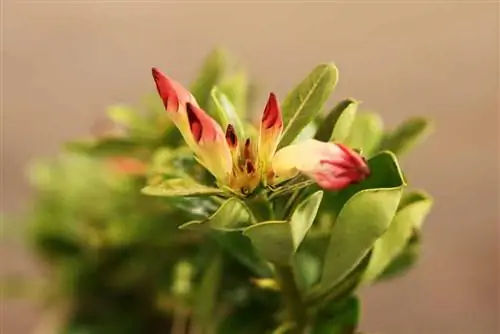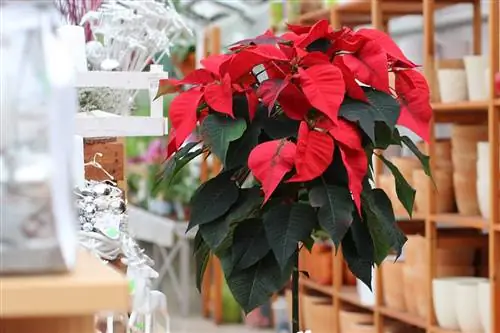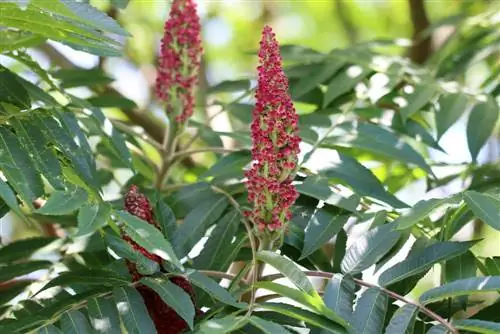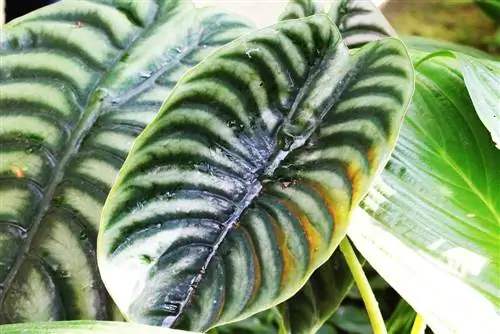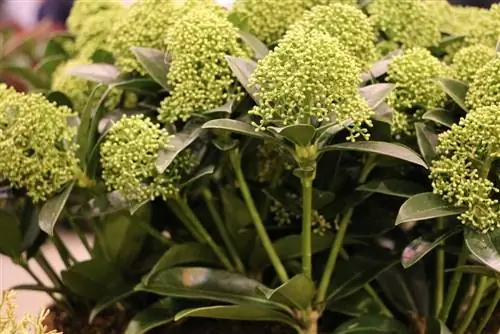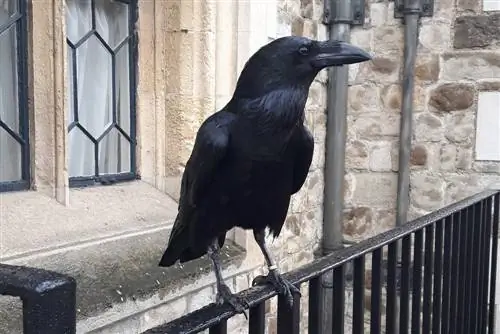- Author admin [email protected].
- Public 2023-12-17 03:39.
- Last modified 2025-01-24 12:45.
The unique value of a desert rose is based particularly on a harmonious balance between the bizarre root system and the idiosyncratic branches. If this consensus is lost because Adenium obesum gets out of hand, hobby gardeners are often at a loss when it comes to pruning. The following cutting tips aim to take this burden off your shoulders. The same applies to yellow foliage, with which the tropical beauty signals discomfort. Get help with yellow leaves here, as we uncover all possible Achilles heels.
Cutting tips
Each desert rose impresses with a unique silhouette, so it is highly likely that there are no two identical specimens in cultivation among hobby gardeners anywhere in the world. This characteristic is primarily due to a balanced relationship between the succulent caudex and the branching. Wherever this harmony is disturbed, the exotic magic is gone. Instead, the big guesswork begins as to whether pruning is possible and how exactly to cut. How to handle the problem correctly:
- The best time for a topiary is towards the end of winter dormancy in spring
- A strong pruning is tolerated as the desert rose sprouts from the old wood
- Reserved cutting is recommended, given the slow growth
- Make each cut 1-2 mm above an outward-facing bud
- Be sure to use freshly ground tools to avoid bruising
- Do not cut into the caudex as the consequences would be fatal
Woody-corky stubs that remain at the interfaces are unavoidable. These disturb the visual appearance for some time until they fall off on their own. This process can be accelerated by smoothing the damaged area with a sharp, disinfected knife after a few months.
Unless you are cultivating a true-root desert rose, but rather a specimen grafted onto an oleander trunk, you will also be confronted with wildlings. These are shoots that sprout from the rootstock and strive to outgrow the weaker desert rose. With a courageous tug, the wild shoots are prevented from doing so. Cutting off the branches only solves the problem for a short time, because they can sprout new ones even from the smallest residue.
Special case of black, rotting shoot tips
You should immediately reach for scissors if your desert rose turns black or brown at the tips of the branches. This damage often results from a break in the wood, broken leaves or flowers. Since fungal spores and pests are waiting for such an opportunity, immediate action is required. First cut the shoot tips back to he althy wood. Then take a look at the internal tissue. If an infection has already developed, continue cutting in small stages until you find fresh, he althy tissue. The interface is ideally sealed with charcoal ash or primary rock dust.
Important:
The desert rose is poisonous in all parts. Wearing protective gloves during all care work is therefore mandatory.
Help with yellow leaves
If a desert rose presents itself with yellow leaves, there are various triggers behind it. In order to get to the bottom of the matter, you need to carry out dedicated research into the cause. The following tips will put you on the right track:
Seasonal leaf coloring
The all-clear can be given immediately as long as the leaves have a seasonal color before they are shed. It may seem surprising at first glance; But the African desert rose adapts to the reduced light conditions from November onwards by going into a dormant state. The leaves thus take on a yellow color, comparable to the autumn color of garden plants.
Tip:
If there are still individual yellow leaves on a desert rose in spring as leftovers from the previous year, they are simply plucked off to make room for the new growth.
Adjust location
One of the most common triggers for yellow leaves on a desert rose is an inappropriate location. Adequate light and temperature conditions should be as follows:
- Full sunny location, warm and protected
- Constantly high temperatures, well over 20 degrees Celsius
- In summer, ideally the sunniest spot in the garden or on the balcony
Although Adenium obesum is one of the most sun-hungry plants, it should still be gradually acclimated to the sun in spring. If the desert rose moves from its winter quarters to the sun-drenched balcony or south-facing window sill in partial shade without hardening off, sunburn will inevitably occur. This damage manifests itself as yellow leaf spots that only heal gradually.
Be careful when repotting
The ideal time to repot the desert rose is at the end of the winter dry rest. Simply paying attention to this point in time will not protect the sensitive plant from yellow leaves if a crucial factor is overlooked. The exotic succulent may only be watered after a waiting period. If you can identify this cause as the trigger, with a little luck the plant can be saved in the following way:
- Potting out the desert rose with the yellow leaves
- Remove the wet substrate as much as possible
- Pot again in bone-dry potting soil and do not water
- A mix of two thirds perlite and one third garden soil is ideal
Wait until the desert rose has recovered from the stress. Only water when fresh, green shoots appear.
Fix nitrogen deficiency
A balanced supply of nutrients at a low level promotes a rich green foliage color and magnificent flowers. If the leaves turn yellow, this deficiency indicates a lack of nitrogen supply. In this case, also give a handful of horn shavings, granulated cattle dung or nettle manure. As soon as the damage improves, switch to a more even NPK fertilization at a dosage of 5-5-5.
Balancing the water balance
As a classic succulent, the desert rose stores an ample supply of water in its caudex. The plant copes much better with a longer dry phase than with waterlogging. If the irrigation water is overdosed, the roots will rot, causing the leaves to turn yellow. If this is the trigger you are looking for, all watering will be stopped immediately. If the desert rose does not recover in the following days and weeks, it should be repotted into a dry substrate even outside the recommended date.

If the African natural beauty suffers from drought, a soft, spongy caudex develops as a result of this deficiency. As it progresses, the leaves turn yellow, dry up and fall off. Therefore, water the desert rose during the summer whenever the thumb test shows that the substrate has dried several centimeters deep.
Tip:
Highly calcareous tap water increases the pH value in the substrate and, in the worst case, causes undesirable yellowing of the foliage. Using rainwater for watering prevents this problem.
Repel pests
If negligence in care can be ruled out as the cause of yellow leaves, a pest infestation comes into focus. Examine your plagued desert rose for the following suspects and combat them immediately with natural remedies:
- Spider mites
- Aphids
- Scale insects
- mealybugs
- Thrips
The effectiveness of chemical preparations for pest control has so far proven to be counterproductive on Adenium obesum. The parasites were destroyed, but so were all the leaves and flowers.
Conclusion
Don't bother with an out-of-shape desert rose any longer. Use these cutting tips to recreate the unique silhouette. If you choose a date in early spring, the pruning can be a little more extensive. However, researching the cause requires a little more effort if the Adenium obesum suffers from yellow foliage. The triggers explained here may serve as well-founded help with yellow leaves.

